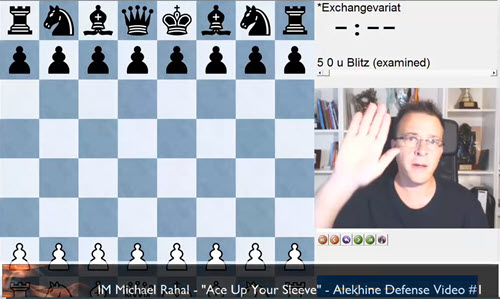Opening: A29: English Opening: Four Knights - Kingside Fianchetto: 1...e5 2.Nc3 Nc6 3.Nf3 Nf6 4.g3
Player(s): Kasparov, Karpov, Ivanchuk
We have seen many examples of double pawns being terribly weak and how the need to protect them with the pieces can lead to dire consequences, such as a complete paralysis of the pieces. Young players are made to be scared to death of double pawns. Literally, they would rather give up a piece than agree to double their pawns. More experienced players know better, yet many of them avoid positions they consider difficult to play because they carry the seeds of potential positional disaster. Are double pawns always bad? I will make the case that they are not. This series of videos opens up our discussion. We will be looking at some lines of the English Opening, where White invites a trade, which causes him to have double pawns on the c-file.
Video #1 introduces White's desired setup that combines the elements of the Botvinnik System with the pawns on c4 and e4, supported by the pawn on d3 with good control over the key d4-square provided by the pawn on c3. White central formation looks unbreakable in the absence of d7-d5 ideas for the opponent. However, there are possibilities of a flank attack with b7-b5 or f7-f5, particularly given Black's lead in development. A fascinating struggle will ensue.
Video#2 illustrates another line that leads to the same pawn formation. In this case, the white forces are fully mobilized, so a wise strategy of flexible defenses, demonstrated by GM Michael Adams, seems an appropriate choice. An all-out attack tried by the author of these words in one of the featured games had a chance to succeed, but it required a great degree of accuracy. In turn, Black's play can also be improved upon.
Now it is time to look at one of the main lines of the English. The Bb4 move, which can be viewed as a Rossolimo Sicilian with colors reversed, has long been considered a solid choice for Black.
In Video #3, we look at some of the earlier games. Former World Champion Vassily Smyslov showed his understanding of the dangers of hesitant play while White is slowly building his desired setup. His remedy was, quite surprisingly, to move the d-pawn two squares and trade it off for White's c-pawn. No double pawns anymore, but Black gets good development and pressure on the open central files in return. The two games offered to your attention led to two different outcomes. Some two decades later these positions became a battleground in the 4th Kasparov-Karpov match in Seville 1987. See Video #4. White Kasparov was able to demonstrate the possibilities for White, Karpov, in turn, came up with a new concept of a pawn sacrifice for Black. All in all, some success and some failure for both sides.
The story continues with Video #5. Yet another great game between Kasparov and Karpov. The latter prevailed thanks to his trademark cold-blooded defense, but Kasparov didn't quit and a year later in the same line he won a textbook game against Vassily Ivanchuk. That last game particularly well illustrates what happens if White breaks through the opponent's defenses.
Download the Games in PGN format
Teacher's library (718) A29 Kasparov Karpov Ivanchuk opening
This is a 5 minute preview.
Log in to watch the full show or click one of the links below.
Page 1 of 92 pages 1 2 3 > Last ›

Added on 07.26.2024
GM Miguel Illescas - Top 10 Checkmate Patterns - Video 17

Added on 07.24.2024
D15 GM Kuljasevic’s “Mastering Closed Position”- Deep Maneuvering

Added on 07.22.2024
IM Rahal Ace up Your Sleeve for Black - Part 5

Added on 07.19.2024
GM Miguel Illescas - Top 10 Checkmate Patterns - Video 16

Added on 07.17.2024
C98 GM Kuljasevic’s “Mastering Closed Position”- Python Squeeze

Added on 07.15.2024
IM Rahal Ace up Your Sleeve for Black - Part 4

Added on 07.12.2024
GM Miguel Illescas - Top 10 Checkmate Patterns - Video 15

Added on 07.10.2024
E74, E29 GM Kuljasevic’s “Mastering Closed Position”- Play on both wings

Added on 07.08.2024
IM Rahal Ace up Your Sleeve for Black - Part 3

Added on 07.05.2024
D26 GM Miguel Illescas - Top 10 Checkmate Patterns - Video 14

Added on 07.03.2024
C01, A09 GM Kuljasevic’s “Mastering Closed Position”- Open Files

Added on 07.01.2024
IM Rahal Ace up Your Sleeve for Black - Part 2

Added on 06.28.2024
GM Miguel Illescas - Top 10 Checkmate Patterns - Video 13

Added on 06.26.2024
E45, E94 GM Kuljasevic’s “Mastering Closed Position”- Semi-open Files

Added on 06.24.2024
IM Rahal Ace up Your Sleeve for Black - Part 1

Added on 06.21.2024
GM Miguel Illescas - Top 10 Checkmate Patterns - Video 12

Added on 06.19.2024
B11, D41 GM Kuljasevic’s “Mastering Closed Position”- Outpost

Added on 06.17.2024
B20 IM Rahal Ace up Your Sleeve - Sicilian Morra Gambit 2

Added on 06.14.2024
GM Miguel Illescas - Top 10 Checkmate Patterns - Video 11

Added on 06.12.2024
E80, C77 GM Kuljasevic’s “Mastering Closed Position”- Breakthrough

Added on 06.10.2024
B20 IM Rahal Ace up Your Sleeve - Sicilian Morra Gambit - Part 1

Added on 06.07.2024
GM Miguel Illescas - Top 10 Checkmate Patterns - Part 10

Added on 06.05.2024
A08, E94 GM Kuljasevic’s “Mastering Closed Position”- Prophylactic Thinking

Added on 06.03.2024
B01 IM Rahal Ace up Your Sleeve - Scandinavian Inverted Budapest Gambit Part 2

Added on 05.31.2024
GM Miguel Illescas - Top 10 Checkmate Patterns - Part 9

Added on 05.29.2024
GM Kuljasevic’s “Mastering Closed Position”- Schematic Thinking - Part 2

Added on 05.27.2024
B01 IM Rahal Ace up Your Sleeve - Scandinavian Inverted Budapest Gambit Part 1

Added on 05.24.2024
GM Miguel Illescas - Top 10 Checkmate Patterns - Part 8

Added on 05.22.2024
E28, C19 GM Kuljasevic’s “Mastering Closed Position”- Schematic Thinking - Part 1

Added on 05.20.2024
C84 IM Rahal Ace up Your Sleeve - Ruy Lopez Centre Attack - Part 1

Added on 05.17.2024
GM Miguel Illescas - Top 10 Checkmate Patterns - Part 7

Added on 05.15.2024
GM Kuljasevic’s “Mastering Closed Position” - Introduction

Added on 05.13.2024
IM Michael Rahal Ace up Your Sleeve - Austrian Attack Part 2

Added on 05.10.2024
GM Miguel Illescas - Top 10 Checkmate Patterns - Part 6

Added on 05.06.2024
B09 IM Michael Rahal Ace up Your Sleeve - Austrian Attack Part 1

Added on 05.03.2024
GM Miguel Illescas - Top 10 Checkmate Patterns - Part 5

Added on 04.29.2024
B00 IM Rahal Ace up Your Sleeve - Nimzowitsch Defense - Part 2

Added on 04.26.2024
GM Miguel Illescas - Top 10 Checkmate Patterns - Part 4

Added on 04.24.2024
GM Davorin Kuljasevic - Mastering Piece Trades - Video 10

Added on 04.22.2024
B00 IM Rahal Ace up Your Sleeve - Nimzowitsch Defense - Part 1

Added on 04.19.2024
E46, A09 GM Miguel Illescas - Top 10 Checkmate Patterns - Part 3

Added on 04.17.2024
GM Davorin Kuljasevic - Mastering Piece Trades - Video 9

Added on 04.15.2024
C00 IM Rahal Ace up Your Sleeve - French Wing Gambit - Part 2

Added on 04.12.2024
GM Miguel Illescas - Top 10 Checkmate Patterns - Part 2

Added on 04.10.2024
GM Davorin Kuljasevic - Mastering Piece Trades - Video 8

Added on 04.08.2024
C00 IM Rahal Ace up Your Sleeve - French Wing Gambit - Part 1

Added on 04.05.2024
A80, A00, C20 GM Miguel Illescas - Top 10 Checkmate Patterns - Part 1

Added on 04.03.2024
GM Davorin Kuljasevic - Mastering Piece Trades - Video 7